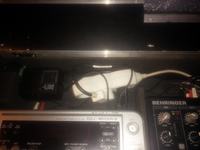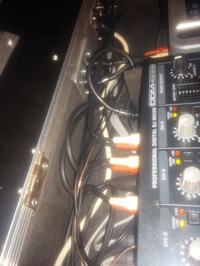Hello
planning to make short RCA signal cables for a DJ console.
I have little space in the case, so the power cables run close to the signal ones, in addition I have 110V players and there is also a converter in the case.
Therefore, it needs cables with the best possible shielding - length 0.7 and 0.5 m. They can be single, or double.
I am thinking of two wires, the Bitner LP0209 microphone.
Technical data:
Number of cores / pairs: 2/1
Insulation: PE
Insulation color: red, natural
Coating: Modified Tire Plastic
Shell color: matt black
Conductors: multi-wire copper, class 6 according to PN-EN 60228
Cross-section of working conductors: 30 AWG copper strand 0.35mm2 / 20x0.15 +- 0.004
Working conductors resistance: 50? / km; + 20 ° C
Screen resistance: 15? / km; + 20 ° C
Core-core capacity: 63pF / m; 1kHz
Effective conductor-screen capacity: 105pF / m; 1kHz
Wire Diameter: 6.5mm ~ 6.6mm
Screen: 160 mesh braid 0.1mm2 wires (95% ... 100%)
Puncture resistance:> 1kV / 50Hz
Temperature range: -30 ° C ~ + 70 ° C
Resistance to: abrasion, animal and vegetable fats, ozone, alcohol, sea water, weak acids and bases and UV
Weight: 55 kg / km
Minimum bending radius:> 20mm
Compliance and standards: ISO 9001 2000; ROHS 2002/95 / EC
/ wire-microphone-cable-2x0-35mm-bitner
I would use it in such a way that the red wire is plus the signal, the white wire is ground, and the screen on one side is connected to ground.
Second cable:
no data, not found anywhere,
instrumental-cable-ins101-double-shielded
I would give the signal through the signal wire, ground with the first shield and the outer shield to ground.
1 cable has any technical specifications, quite good.
The second one has nothing to do but has double shielding, which can give a better effect in such an electromagnetic brothel.
What do you think about it?
planning to make short RCA signal cables for a DJ console.
I have little space in the case, so the power cables run close to the signal ones, in addition I have 110V players and there is also a converter in the case.
Therefore, it needs cables with the best possible shielding - length 0.7 and 0.5 m. They can be single, or double.
I am thinking of two wires, the Bitner LP0209 microphone.
Technical data:
Number of cores / pairs: 2/1
Insulation: PE
Insulation color: red, natural
Coating: Modified Tire Plastic
Shell color: matt black
Conductors: multi-wire copper, class 6 according to PN-EN 60228
Cross-section of working conductors: 30 AWG copper strand 0.35mm2 / 20x0.15 +- 0.004
Working conductors resistance: 50? / km; + 20 ° C
Screen resistance: 15? / km; + 20 ° C
Core-core capacity: 63pF / m; 1kHz
Effective conductor-screen capacity: 105pF / m; 1kHz
Wire Diameter: 6.5mm ~ 6.6mm
Screen: 160 mesh braid 0.1mm2 wires (95% ... 100%)
Puncture resistance:> 1kV / 50Hz
Temperature range: -30 ° C ~ + 70 ° C
Resistance to: abrasion, animal and vegetable fats, ozone, alcohol, sea water, weak acids and bases and UV
Weight: 55 kg / km
Minimum bending radius:> 20mm
Compliance and standards: ISO 9001 2000; ROHS 2002/95 / EC
/ wire-microphone-cable-2x0-35mm-bitner
I would use it in such a way that the red wire is plus the signal, the white wire is ground, and the screen on one side is connected to ground.
Second cable:
no data, not found anywhere,
instrumental-cable-ins101-double-shielded
I would give the signal through the signal wire, ground with the first shield and the outer shield to ground.
1 cable has any technical specifications, quite good.
The second one has nothing to do but has double shielding, which can give a better effect in such an electromagnetic brothel.
What do you think about it?
Moderated By adambyw:3.1.18. Do not send links that will cease to be active after some time. This will make the discussion meaningless.




